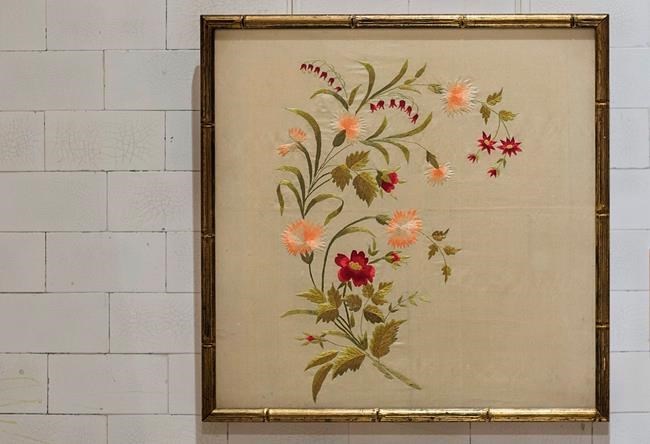
In this picture taken Oct. 1, 2016, a embroidered picture handmade from silkworms by Syria's Shafika Halal is displayed at the "Little Syria, N.Y.: An Immigrant Community's Life and Legacy" exhibit at the Ellis Island National Museum of Immigration. Shafika Halal, came from Syria to the United States in 1910. (AP Photo/Andres Kudacki)
October 14, 2016 - 6:49 AM
NEW YORK - Shakifa Halal was a Syrian immigrant on a New York-bound ship, her dreams rolled up in a piece of embroidery made from silkworms she grew, fabric she wove and cloth dyed with flowers picked in her homeland.
"She rolled that up and brought it because she said she wanted to be able to prove that she had skills ... This to her was like showing a diploma," said Halal's granddaughter, Vicki Tamoush, her voice catching and tears streaming.
Halal's floral artwork, which she brought to America in 1910 at the tender age of 13, now hangs in the Ellis Island National Museum of Immigration, part of an exhibition called "Little Syria, N.Y.: An Immigrant Community's Life and Legacy."
Through documents, artifacts and photos, the exhibition tells the story of a Middle Eastern community that once flourished in Lower Manhattan. The show is on view through Jan. 9 in the building where some 12 million immigrants from around the world first set foot in America. And it documents the vanished neighbourhood of Little Syria in ways that still resonate, at a time when Syrian refugees and immigrant rights are making headlines.
From the 1880s to the 1940s, Little Syria sprawled from the New York waterfront, where Ellis Island ferries dock today, up to the site where the twin towers were later built. It was a slum and a promised land, way station and destination. The neighbourhood served as an incubator for other Arab enclaves, as residents moved on to build communities in Brooklyn, Detroit, Cleveland, Los Angeles and elsewhere. Shakifa Halal was among those who didn't stay long, moving on to join relatives in Oregon, then California. There she found work as a seamstress, likely using that treasured embroidery displayed at Ellis Island to get the job.
But others remained in Manhattan, creating a community in the early 1900s — also known as the Syrian Quarter or Syrian Colony — that was home to some 3,000 immigrants from the Syrian Ottoman Republic. Most of the neighbourhood was torn down in the 1940s to make way for the Brooklyn Battery Tunnel. Just three original buildings survive on Washington Street, and today, the area's ethnic history is largely unknown, even to native New Yorkers. When a cornerstone of a Syrian Maronite church turned up in the rubble of the twin towers in 2002, it provided tangible proof that many Arabs once lived, worked and worshipped here.
"We didn't come out of a genie lamp," said Charlie Sahadi, whose family came from Lebanon to Little Syria in the late 1800s. They launched Sahadi Importing, one of many businesses that helped introduce Middle Eastern goods to consumers here. The Ellis Island exhibition features a 1920s-era picture of Sahadi's great uncle, Abrahim Sahadi, along with A. Sahadi & Co. tins and a 1930s ordering book. The Sahadi store moved to Brooklyn's Atlantic Avenue in the 1940s, but remains a popular gourmet grocery to this day.
The Sahadi story resonates with Devon Akmon, a fourth-generation Arab American and director of the Arab American National Museum in Dearborn, Michigan. The museum created the Little Syria exhibition, which debuted at its facility in 2012.
"You have to honour, celebrate and commemorate who first came, then look at what's happening now," said Akmon, who attended the show's Ellis Island opening Oct. 1. "Arab Americans just became folded into the American narrative and lost in the history of New York City. We're trying to pull that back out."
Reclaiming stories is "essential," he said, as people flee war-torn Syria and amid anti-immigrant rhetoric on the campaign trail: Republican presidential candidate Donald Trump has proposed banning or strictly limiting Syrians and Muslims from entering the U.S. and many governors have sought to curb or change refugee resettlement.
Todd Fine, president of the Washington Street Historical Society, leads tours of the strip where the three structures from Little Syria survive: a tenement building, vacant community house and former Syrian Catholic church that now houses two restaurants. "Some people would say it's kind of miraculous that when everything else is destroyed ... these three little buildings (survive)," he said.
Fine's group and others seek to preserve the historic row, but only the church facade has secured protective landmark status from New York City officials. Meanwhile preservationists are pleased a monument soon will honour the community's literary legacy in a nearby park. Little Syria's writers included famed poet-philosopher Khalil Gibran. And Washington Street once housed offices for the influential "Al Hoda" Arabic newspaper.
Patricia Talisse, who emigrated in 2012 from the Syrian city of Aleppo, said the Ellis Island exhibition elicited tears as she saw the "common values and experiences" between then and now.
"We're here, and we have been for years," said Talisse, who hopes to create an online platform, "Speak to a Syrian," to counter bias and promote understanding.
Vicki Tamoush is grateful her grandmother's embroidery hangs where so many immigrants entered America. Yet she's pained by the reality facing so many fleeing Syria now.
"They're part of a continuum," Tamoush said. "They're not coming here because they want to, they're coming out of desperation. There but for the grace of God ... I could be that, but I'm not because she had that much courage at 13."
___
Follow Jeff Karoub on Twitter at http://twitter.com/jeffkaroub . His work can be found at http://bigstory.ap.org/author/jeff-karoub .
News from © The Associated Press, 2016